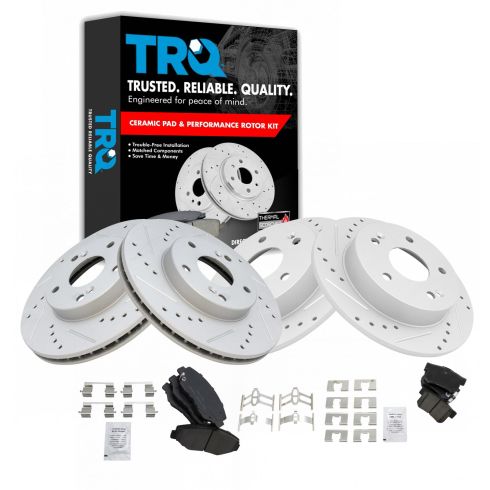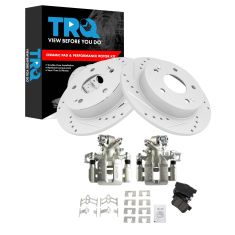1APBS00562-Honda Civic Acura ILX Front & Rear Ceramic Premium G-Coated Performance Brake Pad & Rotor Kit TRQ Performance BKA12453



Replaces
2014 Acura ILX L4 2.0L Front & Rear Ceramic Premium G-Coated Performance Brake Pad & Rotor Kit TRQ Performance BKA12453


Product Reviews
Loading reviews
4.88/ 5.0
8
8 reviews
Great Kit
October 1, 2018
I ordered the kit on a Saturday, they shipped on a Monday, and were delivered on a Wednesday. They were easy to install and they look pretty on my car. So far they work great. Hopefully theyll last be a long time.
Rotor's and Brake pads
May 14, 2019
I Would recommend these Rotors and Brakes very nice products fitting is perfect Work very well on vehicle better than originals
Acura ILX
October 30, 2019
Pads and rotors look good and fit right.
Great package deal and price
December 12, 2019
IT was at a great price point, however, did not come with the rotor screws. Ill definitely use 1 Auto again. The quality seems outstanding.
Perfect
April 29, 2021
Fit my 2013 Honda civic perfectly would highly recommend. Very durable and reliable at a good price.
Life saving brakes!
[{"url": "https://images.turnto.com/media/pNISJll75W64CYGsite/0ab50ab596a89d70aa4713d791e70676_1663527672910_0.jpeg", "caption": ""}, {"url": "https://images.turnto.com/media/pNISJll75W64CYGsite/769aa3f8c6dfeac67fda939404e8c391_1663527672910_1.jpeg", "caption": ""}, {"url": "https://images.turnto.com/media/pNISJll75W64CYGsite/f771c6575afab6df9d6f6053e402a3f9_1663527844147_0.png", "caption": ""}]
September 18, 2022
These brakes saved me from an accident 3 days after I installed them. Somebody started to merge on to the expressway, got nervous and came to a complete halt halfway in my lane. Switching lanes was not an option due to a semi being next to me. This brake and rotor combo took me from 65mph to about 20mph in less than 100ft! I was able to swerve after that and avoid hitting the car. No complaints! As far as the install goes, my hub and rotors were rusted pretty bad so I had to hit the rear ones a few times to get them off. After that, installation was simple. If its your first time taking them off, I would recommend investing in a vessel impact screwdriver to get the screws off the factory rotors. I ended up drilling the ones in the rear out.
May 26, 2023
Great fit
July 10, 2024
Excellent!
Customer Q&A
Will this kit fit on an 2014 Honda civic si also?
March 30, 2019
10
This will not fit the SI model.
March 30, 2019
Peter L
Will this fit 2013 Honda Civic LX?
October 29, 2022
10
This part will not fit your vehicle, but we may have a part that is listed to fit.
Please enter your vehicle's year make and model in the search bar at the top of the page. This will display parts guaranteed to fit your vehicle. Just be sure to verify all of the information shown in the Vehicle Fit tab before ordering.
October 29, 2022
Kelly S
10
Yes the front fits perfectly however I had a mechanic install them and I was told the rear drums and pads would not fit on a 2013 Honda Civic LX Sedan.
October 29, 2022
Tina B
10
Yes the front fits perfectly however I had a mechanic install them and I was told the rear drums and pads would not fit on a 2013 Honda Civic LX Sedan.
October 29, 2022
Tina B
10
Yes the front fits perfectly however I had a mechanic install them and I was told the rear drums and pads would not fit on a 2013 Honda Civic LX Sedan.
October 29, 2022
Tina B
Will this fit my 2013 Honda Civic LX?
October 29, 2022
10
This part will not fit your vehicle, but we may have a part that is listed to fit.
Please enter your vehicle's year make and model in the search bar at the top of the page. This will display parts guaranteed to fit your vehicle. Just be sure to verify all of the information shown in the Vehicle Fit tab before ordering.
October 29, 2022
Kelly S
Does this product fit 2013 honda civic si model ?
February 16, 2023
10
These will fit the EX model only.
February 17, 2023
T I
Acura is a registered trademark of Honda Motor Co., Ltd.. 1A Auto is not affiliated with or sponsored by Acura or Honda Motor Co., Ltd..
See all trademarks.













